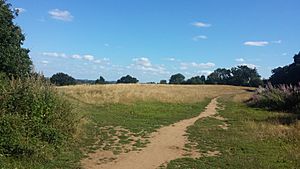McIlroy Park facts for kids
Quick facts for kids McIlroy Park |
|
|---|---|
 |
|
| Type | Local Nature Reserve |
| Location | Reading, Berkshire |
| OS grid | SU 677 743 |
| Area | 12.0 hectares (30 acres) |
| Managed by | Reading Borough Council |
McIlroy Park is a special place in Tilehurst, a part of Reading in Berkshire. It's a Local Nature Reserve, which means it's protected for its wildlife and natural beauty. The park is about 12 hectares (or 30 acres) in size.
Reading Borough Council looks after McIlroy Park. It's also connected to other green spaces like Blundells Copse and Lousehill Copse, forming a larger area called West Reading Woodlands.
Contents
Exploring McIlroy Park's Landscape
McIlroy Park sits on a steep hill, offering great views and different types of scenery. You can find a big field with many kinds of plants and a large area of mixed woodland. This woodland has trees that lose their leaves in autumn.
Cool Features to Discover
As you explore, you'll find two very old paths that are sunken into the ground. These paths wind through the trees. In the western part of the woodland, there are old chalk pits. These pits were left over from when people used to dig for clay long ago. On the eastern side of the park, there might even be an old Saxon mound, which is a small hill possibly made by people from the Saxon times.
McIlroy Park is right next to another nature reserve called Round Copse. They are connected, allowing wildlife to move freely between them.
A Look at McIlroy Park's History
The land for McIlroy Park was given to the town by a kind man named William McIlroy. He owned a big department store in Reading and was also the mayor of the town.
In 1992, this special area was officially named a Local Nature Reserve. This means it's now protected for everyone to enjoy and for nature to thrive.
Amazing Animals of McIlroy Park
McIlroy Park is home to many different animals. Here are some of the creatures you might spot:
Birds You Might See
- Red kite: A large bird of prey with a reddish-brown body and a forked tail.
- Common buzzard: A common bird of prey often seen circling high in the sky.
- Common kestrel: A small falcon that hovers in the air while hunting.
- Common starling: A noisy, social bird with shiny, dark feathers.
- Common whitethroat: A small, brown bird known for its scratchy song.
- Fieldfare: A type of thrush that visits in winter.
- European green woodpecker: A large green woodpecker that often feeds on ants on the ground.
- Dunnock: A small, shy brown bird, sometimes called a hedge sparrow.
- House sparrow: A very common small bird often found near people.
- Mistle thrush: A large thrush known for its loud, fluty song.
- Redwing: A small thrush that visits in winter, with a reddish patch under its wings.
- Song thrush: A brown thrush famous for its varied and musical song.
- Willow warbler: A small, active bird with a sweet, flowing song.
- Eurasian sparrowhawk: A fast bird of prey that hunts other birds.
- Eurasian jay: A colorful bird in the crow family, known for its loud call.
Incredible Insects and More
- Cinnabar moth: A brightly colored moth with red and black wings.
- Bombus ruderarius: A type of bumblebee.
- Scotopteryx chenopodiata: A type of moth.
- Gatekeeper: A common orange and brown butterfly.
- Holly blue: A small, bright blue butterfly.
- Meadow brown: A common brown butterfly found in grasslands.
- Lycaena phlaeas: Also known as the Small Copper butterfly.
- Speckled wood: A brown butterfly with creamy spots, often found in shady areas.
Wonderful Plants of McIlroy Park
The park is also rich in plant life, from tall trees to small flowers and even fungi.
Trees You Can Find
- Acer campestre: Also known as Field Maple.
- Quercus robur: The English Oak tree.
- Fraxinus: Ash trees.
- Hazel: Hazel trees, known for their nuts.
- Ilex aquifolium: Holly, with its spiky leaves and red berries.
- Prunus avium: Wild Cherry trees.
Beautiful Plants and Flowers
- Hyacinthoides non-scripta: The common Bluebell, which creates a stunning blue carpet in spring.
- Catnip: A plant known for attracting cats.
- Mercurialis perennis: Dog's Mercury, a common woodland plant.
- Holcus mollis: Creeping Soft-grass.
- Melica uniflora: Wood Melick, a type of grass.
- Milium effusum: Wood Millet, another type of grass.
- Luzula pilosa: Hairy Wood-rush.
- Moehringia trinervia: Three-nerved Sandwort.
- Calluna: Heather, often found in open, heathland areas.
- Ruscus aculeatus: Butcher's Broom, a plant with stiff, spiny leaves.
Fungi to Spot
- Xylaria polymorpha: Also known as Dead Man's Fingers, a unique-looking fungus.

